Annotated Bibliography: Gun Violence, Mental Health, and Policy
VerifiedAdded on 2022/08/22
|11
|2540
|19
Annotated Bibliography
AI Summary
This annotated bibliography, created in preparation for an issue analysis, compiles and analyzes 14 scholarly and professional sources on the complex relationship between gun violence and mental health, with a specific focus on background checks for firearms and the inclusion of psychiatric health history. The sources, formatted according to APA guidelines, present diverse viewpoints on the issue, including studies on the Cure Violence Model, the link between mental illness and firearm violence, the impact of gun control policies, and the role of mental health in mass shootings. Each entry provides a concise synopsis, an assessment of the source's trustworthiness and validity, and an evaluation of its usefulness for research, ensuring a comprehensive overview of the current understanding and debates surrounding gun violence, mental health, and policy implications. The bibliography includes studies on the effectiveness of current gun policies and the influence of media, along with discussions of the ethical and legal contexts of firearm ownership. The author has critically reviewed the selected laws and policies and recommendations for evidence-based policy were presented. The overall goal is to provide a solid foundation for a thorough examination of this critical public health issue.
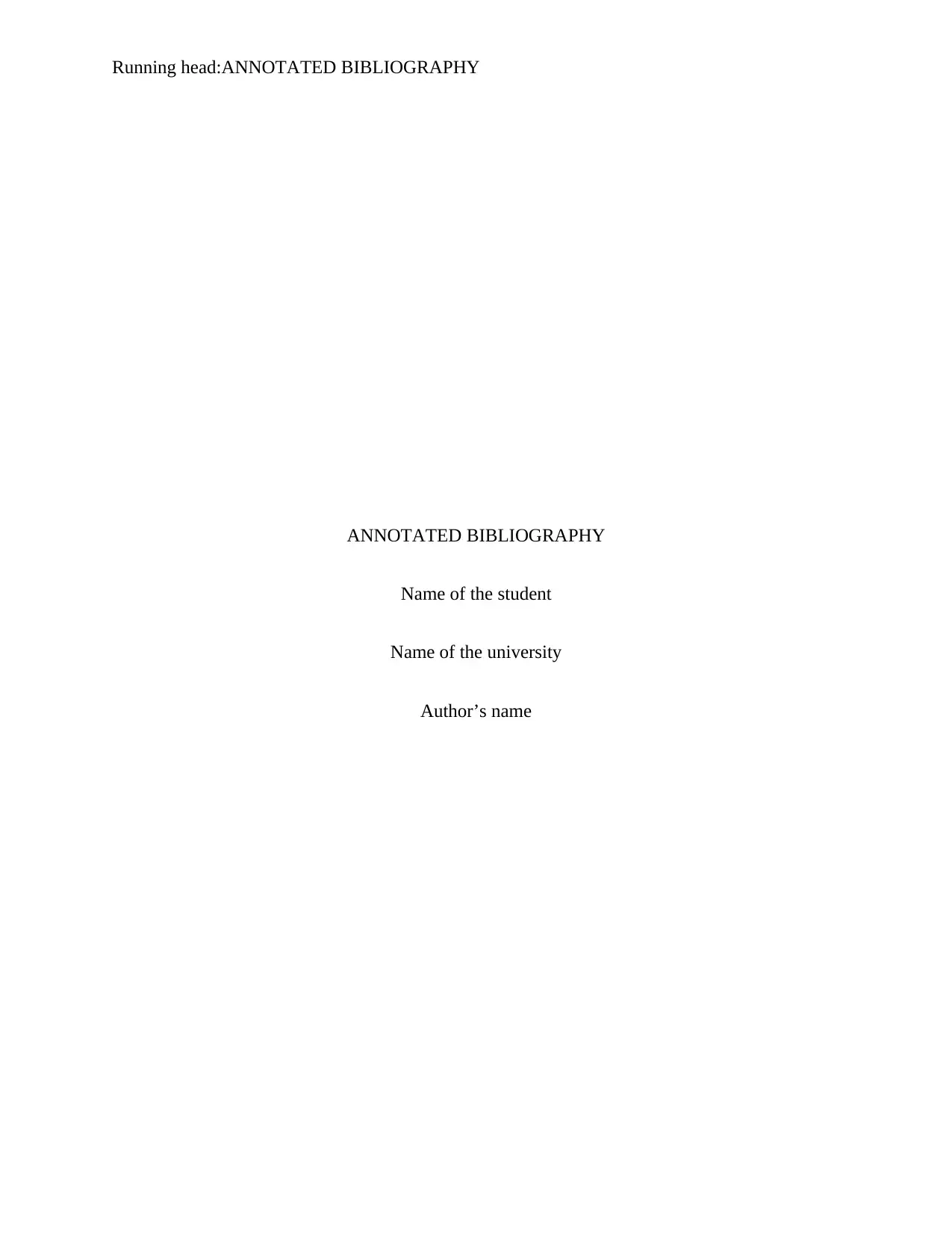
Running head:ANNOTATED BIBLIOGRAPHY
ANNOTATED BIBLIOGRAPHY
Name of the student
Name of the university
Author’s name
ANNOTATED BIBLIOGRAPHY
Name of the student
Name of the university
Author’s name
Paraphrase This Document
Need a fresh take? Get an instant paraphrase of this document with our AI Paraphraser

ANNOTATED BIBLIOGRAPHY
Butts, J. A., Roman, C. G., Bostwick, L., & Porter, J. R. (2015). Cure violence: a public
health model to reduce gun violence. Annual Review of Public Health, 36, 39-53.
Recent studies and evidences suggest that achieving valid and permanent progress in the
combat against gun violence entail changes in the field of social norm and attitude perpetuate
violence and gun usage. Thus, in response to the aim of reducing gun violence, the Cure
Violence Model, a public health approach came into force. This model primarily aims to reduce
gun violence by changing both individual as well as community norms and attitudes regarding
gun violence. On the same grounds, the article by Butts et al. (2015) gives an overview of the
theoretical basis for this program, review the program evaluations that already exist and
categorize several challenge faced by the evaluators and also provides implications for future
study. The main focus of this article is on a particular strategy for violence reduction, inspired by
public health approach. Cure Violence that has been developed with the aim to bring individual
and community level changes in community where young people are often seen to carry guns
and for some, to use gun in the form of conflict with others.
Swanson, J. W., McGinty, E. E., Fazel, S., & Mays, V. M. (2015). Mental illness and
reduction of gun violence and suicide: bringing epidemiologic research to policy. Annals of
epidemiology, 25(5), 366-376.
This epidemiological study discusses and brings out epidemiological evidences
underlining gun violence and suicide risk and their relationship with psychiatric disorders, in
comparison to the media driven public awareness of the risks of mental sick individuals. The
study also evaluate and determine the effectiveness of the existing policies and laws that have
been designed with the aim to prevent injuries related to firearms and mortality linked with
Butts, J. A., Roman, C. G., Bostwick, L., & Porter, J. R. (2015). Cure violence: a public
health model to reduce gun violence. Annual Review of Public Health, 36, 39-53.
Recent studies and evidences suggest that achieving valid and permanent progress in the
combat against gun violence entail changes in the field of social norm and attitude perpetuate
violence and gun usage. Thus, in response to the aim of reducing gun violence, the Cure
Violence Model, a public health approach came into force. This model primarily aims to reduce
gun violence by changing both individual as well as community norms and attitudes regarding
gun violence. On the same grounds, the article by Butts et al. (2015) gives an overview of the
theoretical basis for this program, review the program evaluations that already exist and
categorize several challenge faced by the evaluators and also provides implications for future
study. The main focus of this article is on a particular strategy for violence reduction, inspired by
public health approach. Cure Violence that has been developed with the aim to bring individual
and community level changes in community where young people are often seen to carry guns
and for some, to use gun in the form of conflict with others.
Swanson, J. W., McGinty, E. E., Fazel, S., & Mays, V. M. (2015). Mental illness and
reduction of gun violence and suicide: bringing epidemiologic research to policy. Annals of
epidemiology, 25(5), 366-376.
This epidemiological study discusses and brings out epidemiological evidences
underlining gun violence and suicide risk and their relationship with psychiatric disorders, in
comparison to the media driven public awareness of the risks of mental sick individuals. The
study also evaluate and determine the effectiveness of the existing policies and laws that have
been designed with the aim to prevent injuries related to firearms and mortality linked with
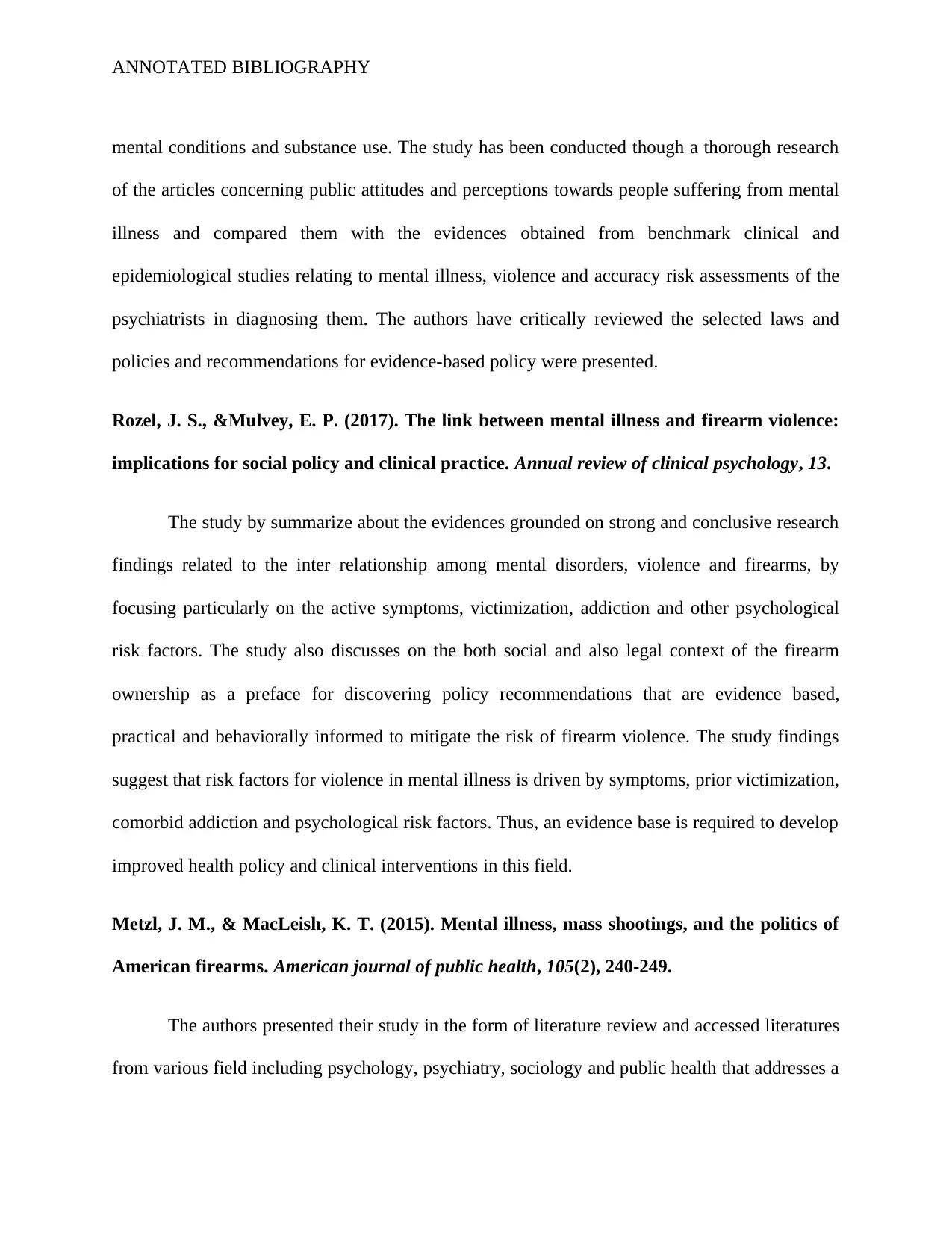
ANNOTATED BIBLIOGRAPHY
mental conditions and substance use. The study has been conducted though a thorough research
of the articles concerning public attitudes and perceptions towards people suffering from mental
illness and compared them with the evidences obtained from benchmark clinical and
epidemiological studies relating to mental illness, violence and accuracy risk assessments of the
psychiatrists in diagnosing them. The authors have critically reviewed the selected laws and
policies and recommendations for evidence-based policy were presented.
Rozel, J. S., &Mulvey, E. P. (2017). The link between mental illness and firearm violence:
implications for social policy and clinical practice. Annual review of clinical psychology, 13.
The study by summarize about the evidences grounded on strong and conclusive research
findings related to the inter relationship among mental disorders, violence and firearms, by
focusing particularly on the active symptoms, victimization, addiction and other psychological
risk factors. The study also discusses on the both social and also legal context of the firearm
ownership as a preface for discovering policy recommendations that are evidence based,
practical and behaviorally informed to mitigate the risk of firearm violence. The study findings
suggest that risk factors for violence in mental illness is driven by symptoms, prior victimization,
comorbid addiction and psychological risk factors. Thus, an evidence base is required to develop
improved health policy and clinical interventions in this field.
Metzl, J. M., & MacLeish, K. T. (2015). Mental illness, mass shootings, and the politics of
American firearms. American journal of public health, 105(2), 240-249.
The authors presented their study in the form of literature review and accessed literatures
from various field including psychology, psychiatry, sociology and public health that addresses a
mental conditions and substance use. The study has been conducted though a thorough research
of the articles concerning public attitudes and perceptions towards people suffering from mental
illness and compared them with the evidences obtained from benchmark clinical and
epidemiological studies relating to mental illness, violence and accuracy risk assessments of the
psychiatrists in diagnosing them. The authors have critically reviewed the selected laws and
policies and recommendations for evidence-based policy were presented.
Rozel, J. S., &Mulvey, E. P. (2017). The link between mental illness and firearm violence:
implications for social policy and clinical practice. Annual review of clinical psychology, 13.
The study by summarize about the evidences grounded on strong and conclusive research
findings related to the inter relationship among mental disorders, violence and firearms, by
focusing particularly on the active symptoms, victimization, addiction and other psychological
risk factors. The study also discusses on the both social and also legal context of the firearm
ownership as a preface for discovering policy recommendations that are evidence based,
practical and behaviorally informed to mitigate the risk of firearm violence. The study findings
suggest that risk factors for violence in mental illness is driven by symptoms, prior victimization,
comorbid addiction and psychological risk factors. Thus, an evidence base is required to develop
improved health policy and clinical interventions in this field.
Metzl, J. M., & MacLeish, K. T. (2015). Mental illness, mass shootings, and the politics of
American firearms. American journal of public health, 105(2), 240-249.
The authors presented their study in the form of literature review and accessed literatures
from various field including psychology, psychiatry, sociology and public health that addresses a
⊘ This is a preview!⊘
Do you want full access?
Subscribe today to unlock all pages.

Trusted by 1+ million students worldwide
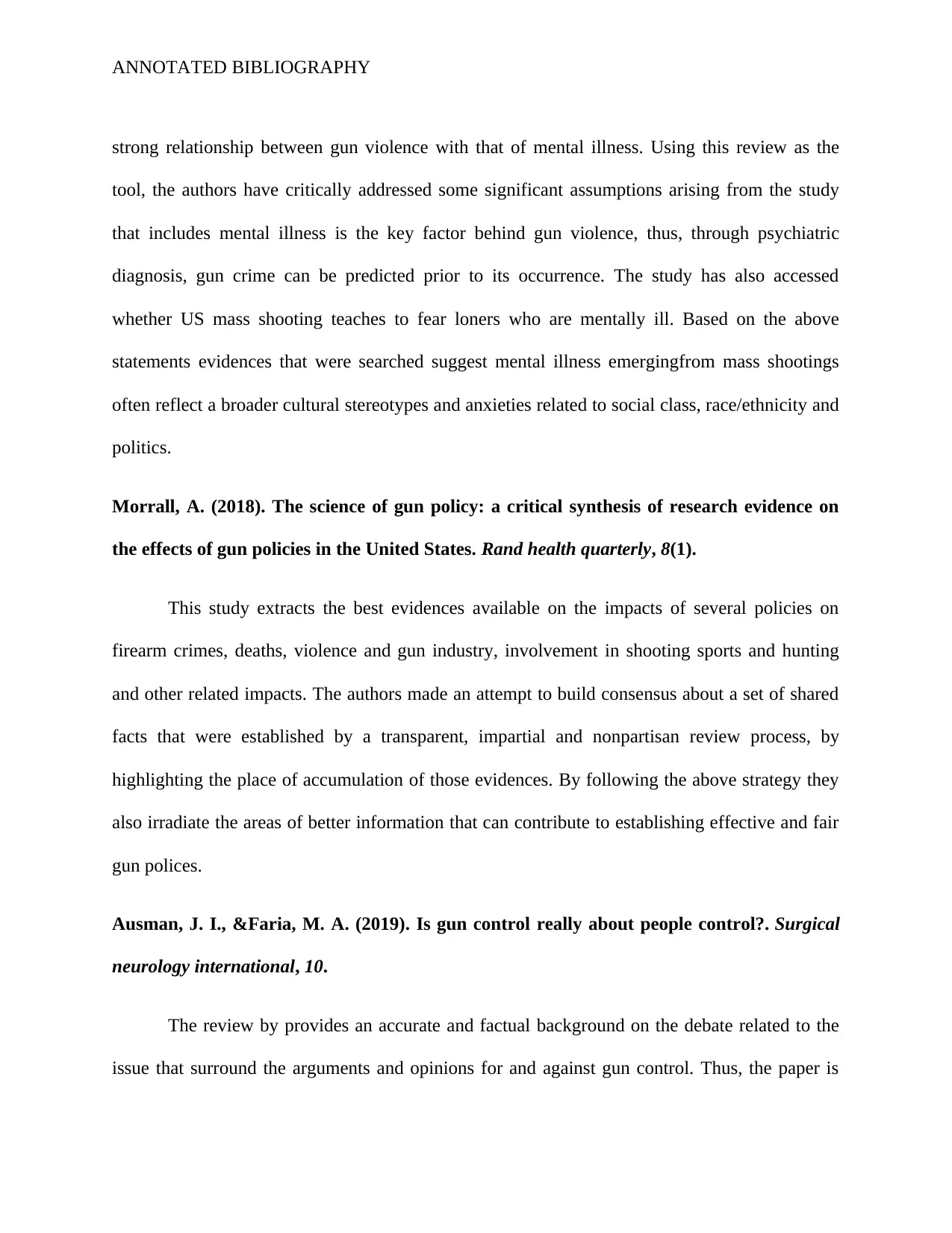
ANNOTATED BIBLIOGRAPHY
strong relationship between gun violence with that of mental illness. Using this review as the
tool, the authors have critically addressed some significant assumptions arising from the study
that includes mental illness is the key factor behind gun violence, thus, through psychiatric
diagnosis, gun crime can be predicted prior to its occurrence. The study has also accessed
whether US mass shooting teaches to fear loners who are mentally ill. Based on the above
statements evidences that were searched suggest mental illness emergingfrom mass shootings
often reflect a broader cultural stereotypes and anxieties related to social class, race/ethnicity and
politics.
Morrall, A. (2018). The science of gun policy: a critical synthesis of research evidence on
the effects of gun policies in the United States. Rand health quarterly, 8(1).
This study extracts the best evidences available on the impacts of several policies on
firearm crimes, deaths, violence and gun industry, involvement in shooting sports and hunting
and other related impacts. The authors made an attempt to build consensus about a set of shared
facts that were established by a transparent, impartial and nonpartisan review process, by
highlighting the place of accumulation of those evidences. By following the above strategy they
also irradiate the areas of better information that can contribute to establishing effective and fair
gun polices.
Ausman, J. I., &Faria, M. A. (2019). Is gun control really about people control?. Surgical
neurology international, 10.
The review by provides an accurate and factual background on the debate related to the
issue that surround the arguments and opinions for and against gun control. Thus, the paper is
strong relationship between gun violence with that of mental illness. Using this review as the
tool, the authors have critically addressed some significant assumptions arising from the study
that includes mental illness is the key factor behind gun violence, thus, through psychiatric
diagnosis, gun crime can be predicted prior to its occurrence. The study has also accessed
whether US mass shooting teaches to fear loners who are mentally ill. Based on the above
statements evidences that were searched suggest mental illness emergingfrom mass shootings
often reflect a broader cultural stereotypes and anxieties related to social class, race/ethnicity and
politics.
Morrall, A. (2018). The science of gun policy: a critical synthesis of research evidence on
the effects of gun policies in the United States. Rand health quarterly, 8(1).
This study extracts the best evidences available on the impacts of several policies on
firearm crimes, deaths, violence and gun industry, involvement in shooting sports and hunting
and other related impacts. The authors made an attempt to build consensus about a set of shared
facts that were established by a transparent, impartial and nonpartisan review process, by
highlighting the place of accumulation of those evidences. By following the above strategy they
also irradiate the areas of better information that can contribute to establishing effective and fair
gun polices.
Ausman, J. I., &Faria, M. A. (2019). Is gun control really about people control?. Surgical
neurology international, 10.
The review by provides an accurate and factual background on the debate related to the
issue that surround the arguments and opinions for and against gun control. Thus, the paper is
Paraphrase This Document
Need a fresh take? Get an instant paraphrase of this document with our AI Paraphraser
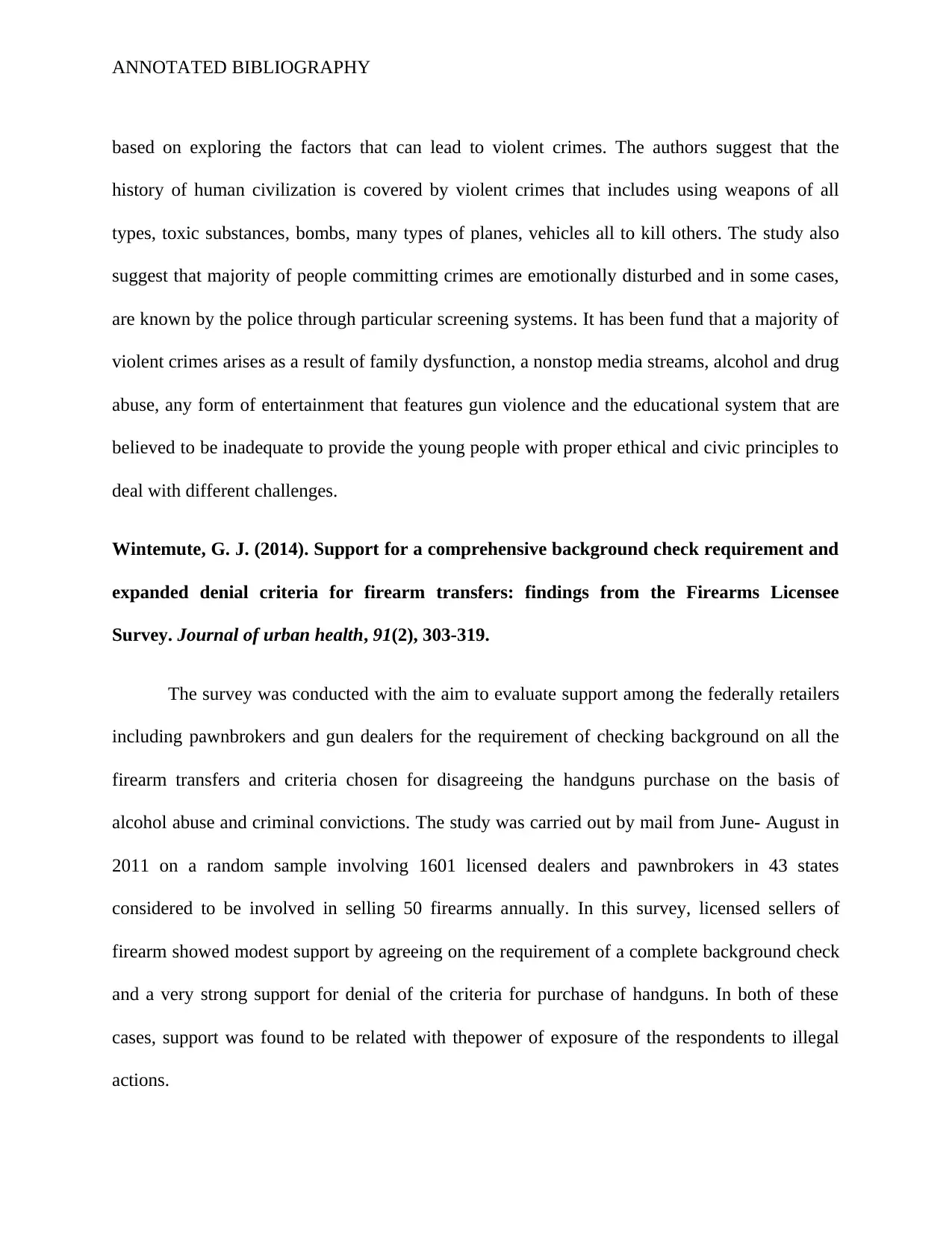
ANNOTATED BIBLIOGRAPHY
based on exploring the factors that can lead to violent crimes. The authors suggest that the
history of human civilization is covered by violent crimes that includes using weapons of all
types, toxic substances, bombs, many types of planes, vehicles all to kill others. The study also
suggest that majority of people committing crimes are emotionally disturbed and in some cases,
are known by the police through particular screening systems. It has been fund that a majority of
violent crimes arises as a result of family dysfunction, a nonstop media streams, alcohol and drug
abuse, any form of entertainment that features gun violence and the educational system that are
believed to be inadequate to provide the young people with proper ethical and civic principles to
deal with different challenges.
Wintemute, G. J. (2014). Support for a comprehensive background check requirement and
expanded denial criteria for firearm transfers: findings from the Firearms Licensee
Survey. Journal of urban health, 91(2), 303-319.
The survey was conducted with the aim to evaluate support among the federally retailers
including pawnbrokers and gun dealers for the requirement of checking background on all the
firearm transfers and criteria chosen for disagreeing the handguns purchase on the basis of
alcohol abuse and criminal convictions. The study was carried out by mail from June- August in
2011 on a random sample involving 1601 licensed dealers and pawnbrokers in 43 states
considered to be involved in selling 50 firearms annually. In this survey, licensed sellers of
firearm showed modest support by agreeing on the requirement of a complete background check
and a very strong support for denial of the criteria for purchase of handguns. In both of these
cases, support was found to be related with thepower of exposure of the respondents to illegal
actions.
based on exploring the factors that can lead to violent crimes. The authors suggest that the
history of human civilization is covered by violent crimes that includes using weapons of all
types, toxic substances, bombs, many types of planes, vehicles all to kill others. The study also
suggest that majority of people committing crimes are emotionally disturbed and in some cases,
are known by the police through particular screening systems. It has been fund that a majority of
violent crimes arises as a result of family dysfunction, a nonstop media streams, alcohol and drug
abuse, any form of entertainment that features gun violence and the educational system that are
believed to be inadequate to provide the young people with proper ethical and civic principles to
deal with different challenges.
Wintemute, G. J. (2014). Support for a comprehensive background check requirement and
expanded denial criteria for firearm transfers: findings from the Firearms Licensee
Survey. Journal of urban health, 91(2), 303-319.
The survey was conducted with the aim to evaluate support among the federally retailers
including pawnbrokers and gun dealers for the requirement of checking background on all the
firearm transfers and criteria chosen for disagreeing the handguns purchase on the basis of
alcohol abuse and criminal convictions. The study was carried out by mail from June- August in
2011 on a random sample involving 1601 licensed dealers and pawnbrokers in 43 states
considered to be involved in selling 50 firearms annually. In this survey, licensed sellers of
firearm showed modest support by agreeing on the requirement of a complete background check
and a very strong support for denial of the criteria for purchase of handguns. In both of these
cases, support was found to be related with thepower of exposure of the respondents to illegal
actions.
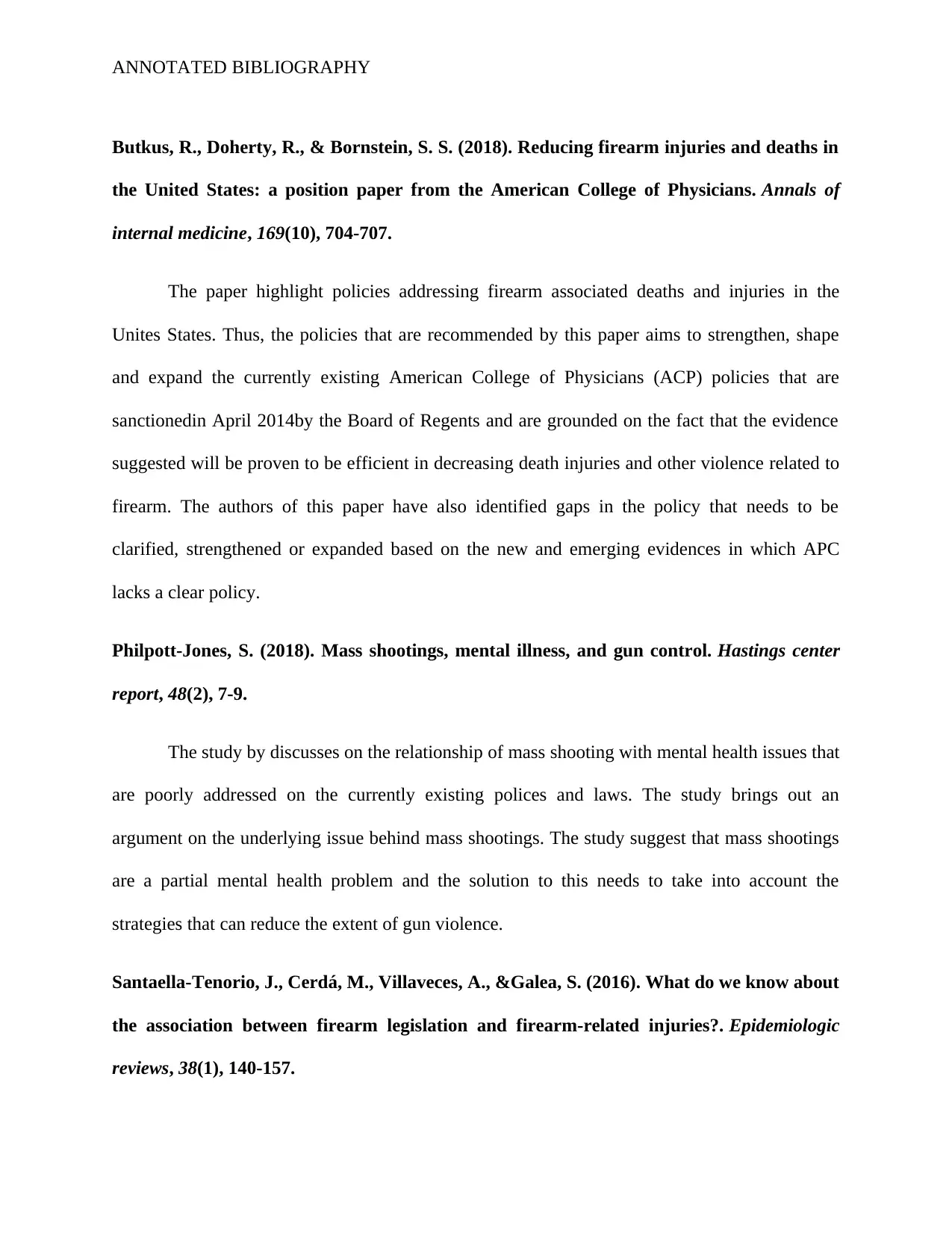
ANNOTATED BIBLIOGRAPHY
Butkus, R., Doherty, R., & Bornstein, S. S. (2018). Reducing firearm injuries and deaths in
the United States: a position paper from the American College of Physicians. Annals of
internal medicine, 169(10), 704-707.
The paper highlight policies addressing firearm associated deaths and injuries in the
Unites States. Thus, the policies that are recommended by this paper aims to strengthen, shape
and expand the currently existing American College of Physicians (ACP) policies that are
sanctionedin April 2014by the Board of Regents and are grounded on the fact that the evidence
suggested will be proven to be efficient in decreasing death injuries and other violence related to
firearm. The authors of this paper have also identified gaps in the policy that needs to be
clarified, strengthened or expanded based on the new and emerging evidences in which APC
lacks a clear policy.
Philpott‐Jones, S. (2018). Mass shootings, mental illness, and gun control. Hastings center
report, 48(2), 7-9.
The study by discusses on the relationship of mass shooting with mental health issues that
are poorly addressed on the currently existing polices and laws. The study brings out an
argument on the underlying issue behind mass shootings. The study suggest that mass shootings
are a partial mental health problem and the solution to this needs to take into account the
strategies that can reduce the extent of gun violence.
Santaella-Tenorio, J., Cerdá, M., Villaveces, A., &Galea, S. (2016). What do we know about
the association between firearm legislation and firearm-related injuries?. Epidemiologic
reviews, 38(1), 140-157.
Butkus, R., Doherty, R., & Bornstein, S. S. (2018). Reducing firearm injuries and deaths in
the United States: a position paper from the American College of Physicians. Annals of
internal medicine, 169(10), 704-707.
The paper highlight policies addressing firearm associated deaths and injuries in the
Unites States. Thus, the policies that are recommended by this paper aims to strengthen, shape
and expand the currently existing American College of Physicians (ACP) policies that are
sanctionedin April 2014by the Board of Regents and are grounded on the fact that the evidence
suggested will be proven to be efficient in decreasing death injuries and other violence related to
firearm. The authors of this paper have also identified gaps in the policy that needs to be
clarified, strengthened or expanded based on the new and emerging evidences in which APC
lacks a clear policy.
Philpott‐Jones, S. (2018). Mass shootings, mental illness, and gun control. Hastings center
report, 48(2), 7-9.
The study by discusses on the relationship of mass shooting with mental health issues that
are poorly addressed on the currently existing polices and laws. The study brings out an
argument on the underlying issue behind mass shootings. The study suggest that mass shootings
are a partial mental health problem and the solution to this needs to take into account the
strategies that can reduce the extent of gun violence.
Santaella-Tenorio, J., Cerdá, M., Villaveces, A., &Galea, S. (2016). What do we know about
the association between firearm legislation and firearm-related injuries?. Epidemiologic
reviews, 38(1), 140-157.
⊘ This is a preview!⊘
Do you want full access?
Subscribe today to unlock all pages.

Trusted by 1+ million students worldwide
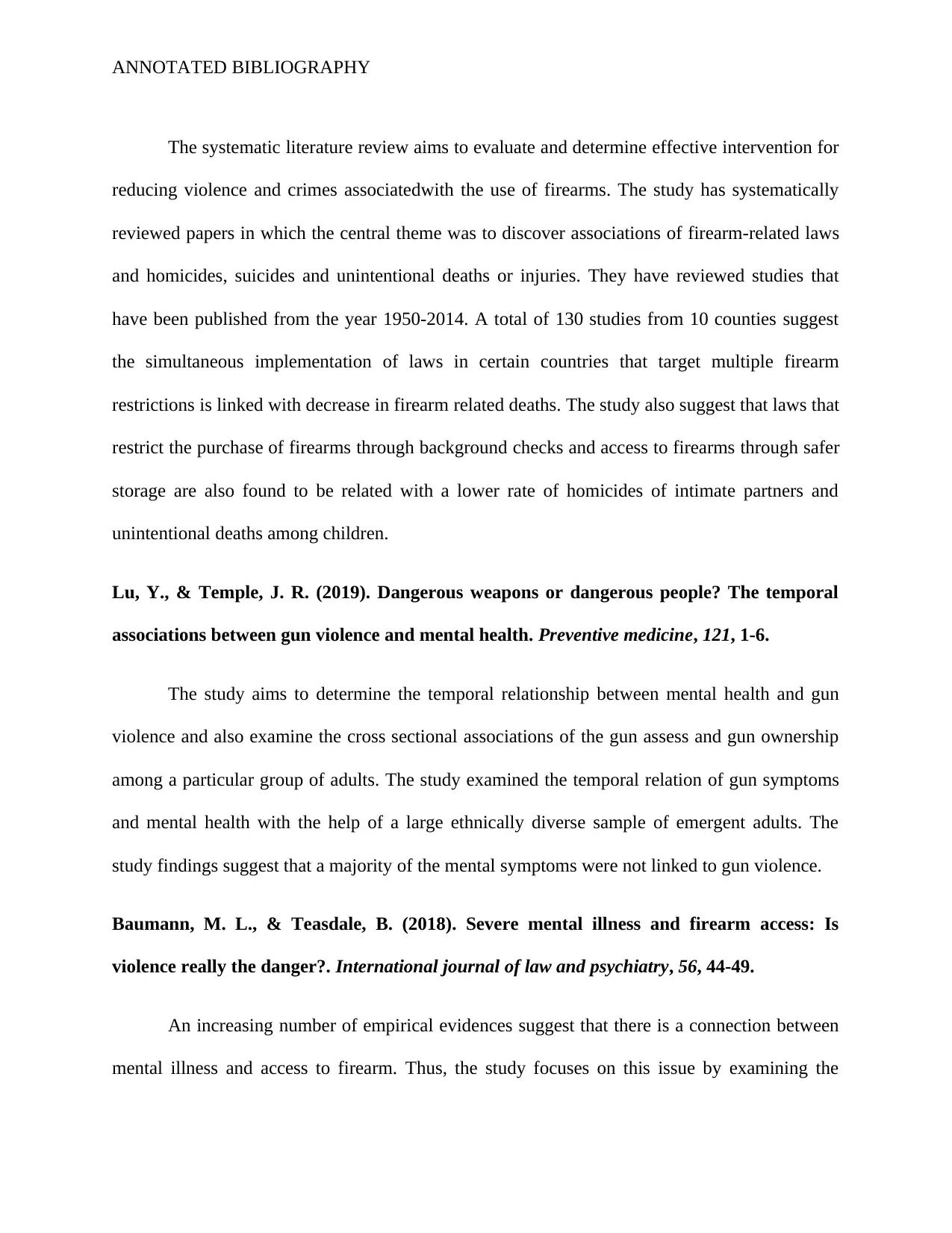
ANNOTATED BIBLIOGRAPHY
The systematic literature review aims to evaluate and determine effective intervention for
reducing violence and crimes associatedwith the use of firearms. The study has systematically
reviewed papers in which the central theme was to discover associations of firearm-related laws
and homicides, suicides and unintentional deaths or injuries. They have reviewed studies that
have been published from the year 1950-2014. A total of 130 studies from 10 counties suggest
the simultaneous implementation of laws in certain countries that target multiple firearm
restrictions is linked with decrease in firearm related deaths. The study also suggest that laws that
restrict the purchase of firearms through background checks and access to firearms through safer
storage are also found to be related with a lower rate of homicides of intimate partners and
unintentional deaths among children.
Lu, Y., & Temple, J. R. (2019). Dangerous weapons or dangerous people? The temporal
associations between gun violence and mental health. Preventive medicine, 121, 1-6.
The study aims to determine the temporal relationship between mental health and gun
violence and also examine the cross sectional associations of the gun assess and gun ownership
among a particular group of adults. The study examined the temporal relation of gun symptoms
and mental health with the help of a large ethnically diverse sample of emergent adults. The
study findings suggest that a majority of the mental symptoms were not linked to gun violence.
Baumann, M. L., & Teasdale, B. (2018). Severe mental illness and firearm access: Is
violence really the danger?. International journal of law and psychiatry, 56, 44-49.
An increasing number of empirical evidences suggest that there is a connection between
mental illness and access to firearm. Thus, the study focuses on this issue by examining the
The systematic literature review aims to evaluate and determine effective intervention for
reducing violence and crimes associatedwith the use of firearms. The study has systematically
reviewed papers in which the central theme was to discover associations of firearm-related laws
and homicides, suicides and unintentional deaths or injuries. They have reviewed studies that
have been published from the year 1950-2014. A total of 130 studies from 10 counties suggest
the simultaneous implementation of laws in certain countries that target multiple firearm
restrictions is linked with decrease in firearm related deaths. The study also suggest that laws that
restrict the purchase of firearms through background checks and access to firearms through safer
storage are also found to be related with a lower rate of homicides of intimate partners and
unintentional deaths among children.
Lu, Y., & Temple, J. R. (2019). Dangerous weapons or dangerous people? The temporal
associations between gun violence and mental health. Preventive medicine, 121, 1-6.
The study aims to determine the temporal relationship between mental health and gun
violence and also examine the cross sectional associations of the gun assess and gun ownership
among a particular group of adults. The study examined the temporal relation of gun symptoms
and mental health with the help of a large ethnically diverse sample of emergent adults. The
study findings suggest that a majority of the mental symptoms were not linked to gun violence.
Baumann, M. L., & Teasdale, B. (2018). Severe mental illness and firearm access: Is
violence really the danger?. International journal of law and psychiatry, 56, 44-49.
An increasing number of empirical evidences suggest that there is a connection between
mental illness and access to firearm. Thus, the study focuses on this issue by examining the
Paraphrase This Document
Need a fresh take? Get an instant paraphrase of this document with our AI Paraphraser
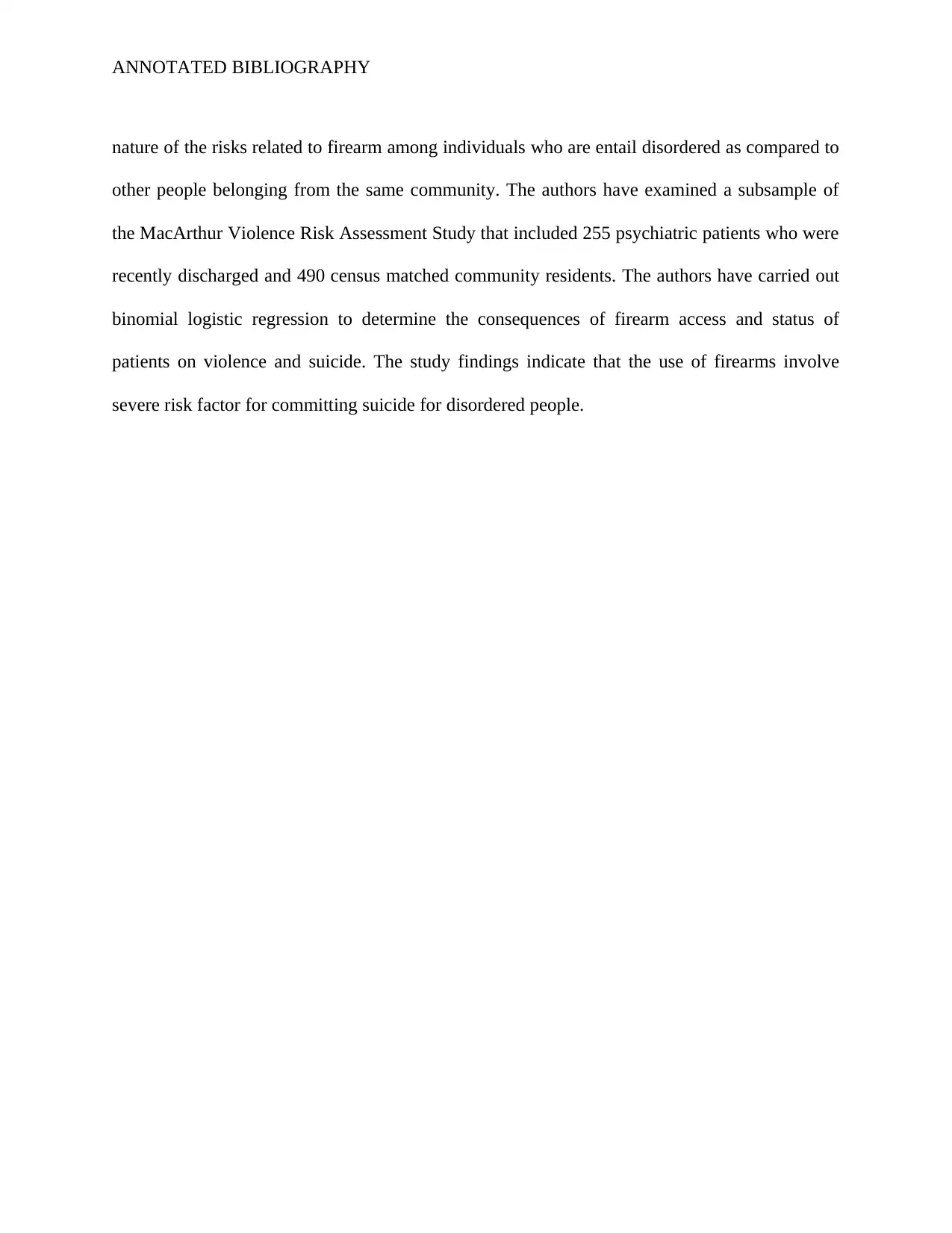
ANNOTATED BIBLIOGRAPHY
nature of the risks related to firearm among individuals who are entail disordered as compared to
other people belonging from the same community. The authors have examined a subsample of
the MacArthur Violence Risk Assessment Study that included 255 psychiatric patients who were
recently discharged and 490 census matched community residents. The authors have carried out
binomial logistic regression to determine the consequences of firearm access and status of
patients on violence and suicide. The study findings indicate that the use of firearms involve
severe risk factor for committing suicide for disordered people.
nature of the risks related to firearm among individuals who are entail disordered as compared to
other people belonging from the same community. The authors have examined a subsample of
the MacArthur Violence Risk Assessment Study that included 255 psychiatric patients who were
recently discharged and 490 census matched community residents. The authors have carried out
binomial logistic regression to determine the consequences of firearm access and status of
patients on violence and suicide. The study findings indicate that the use of firearms involve
severe risk factor for committing suicide for disordered people.
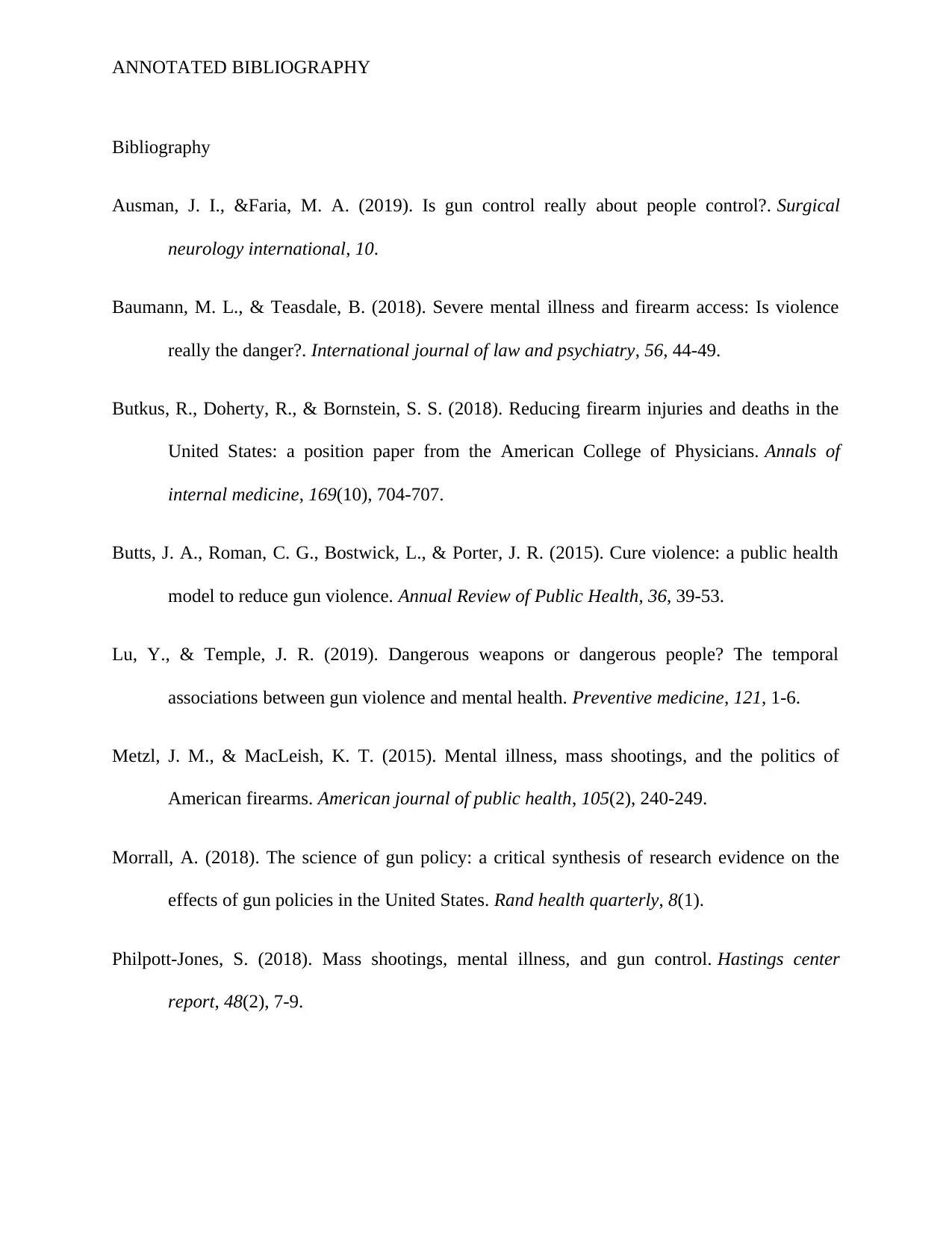
ANNOTATED BIBLIOGRAPHY
Bibliography
Ausman, J. I., &Faria, M. A. (2019). Is gun control really about people control?. Surgical
neurology international, 10.
Baumann, M. L., & Teasdale, B. (2018). Severe mental illness and firearm access: Is violence
really the danger?. International journal of law and psychiatry, 56, 44-49.
Butkus, R., Doherty, R., & Bornstein, S. S. (2018). Reducing firearm injuries and deaths in the
United States: a position paper from the American College of Physicians. Annals of
internal medicine, 169(10), 704-707.
Butts, J. A., Roman, C. G., Bostwick, L., & Porter, J. R. (2015). Cure violence: a public health
model to reduce gun violence. Annual Review of Public Health, 36, 39-53.
Lu, Y., & Temple, J. R. (2019). Dangerous weapons or dangerous people? The temporal
associations between gun violence and mental health. Preventive medicine, 121, 1-6.
Metzl, J. M., & MacLeish, K. T. (2015). Mental illness, mass shootings, and the politics of
American firearms. American journal of public health, 105(2), 240-249.
Morrall, A. (2018). The science of gun policy: a critical synthesis of research evidence on the
effects of gun policies in the United States. Rand health quarterly, 8(1).
Philpott‐Jones, S. (2018). Mass shootings, mental illness, and gun control. Hastings center
report, 48(2), 7-9.
Bibliography
Ausman, J. I., &Faria, M. A. (2019). Is gun control really about people control?. Surgical
neurology international, 10.
Baumann, M. L., & Teasdale, B. (2018). Severe mental illness and firearm access: Is violence
really the danger?. International journal of law and psychiatry, 56, 44-49.
Butkus, R., Doherty, R., & Bornstein, S. S. (2018). Reducing firearm injuries and deaths in the
United States: a position paper from the American College of Physicians. Annals of
internal medicine, 169(10), 704-707.
Butts, J. A., Roman, C. G., Bostwick, L., & Porter, J. R. (2015). Cure violence: a public health
model to reduce gun violence. Annual Review of Public Health, 36, 39-53.
Lu, Y., & Temple, J. R. (2019). Dangerous weapons or dangerous people? The temporal
associations between gun violence and mental health. Preventive medicine, 121, 1-6.
Metzl, J. M., & MacLeish, K. T. (2015). Mental illness, mass shootings, and the politics of
American firearms. American journal of public health, 105(2), 240-249.
Morrall, A. (2018). The science of gun policy: a critical synthesis of research evidence on the
effects of gun policies in the United States. Rand health quarterly, 8(1).
Philpott‐Jones, S. (2018). Mass shootings, mental illness, and gun control. Hastings center
report, 48(2), 7-9.
⊘ This is a preview!⊘
Do you want full access?
Subscribe today to unlock all pages.

Trusted by 1+ million students worldwide
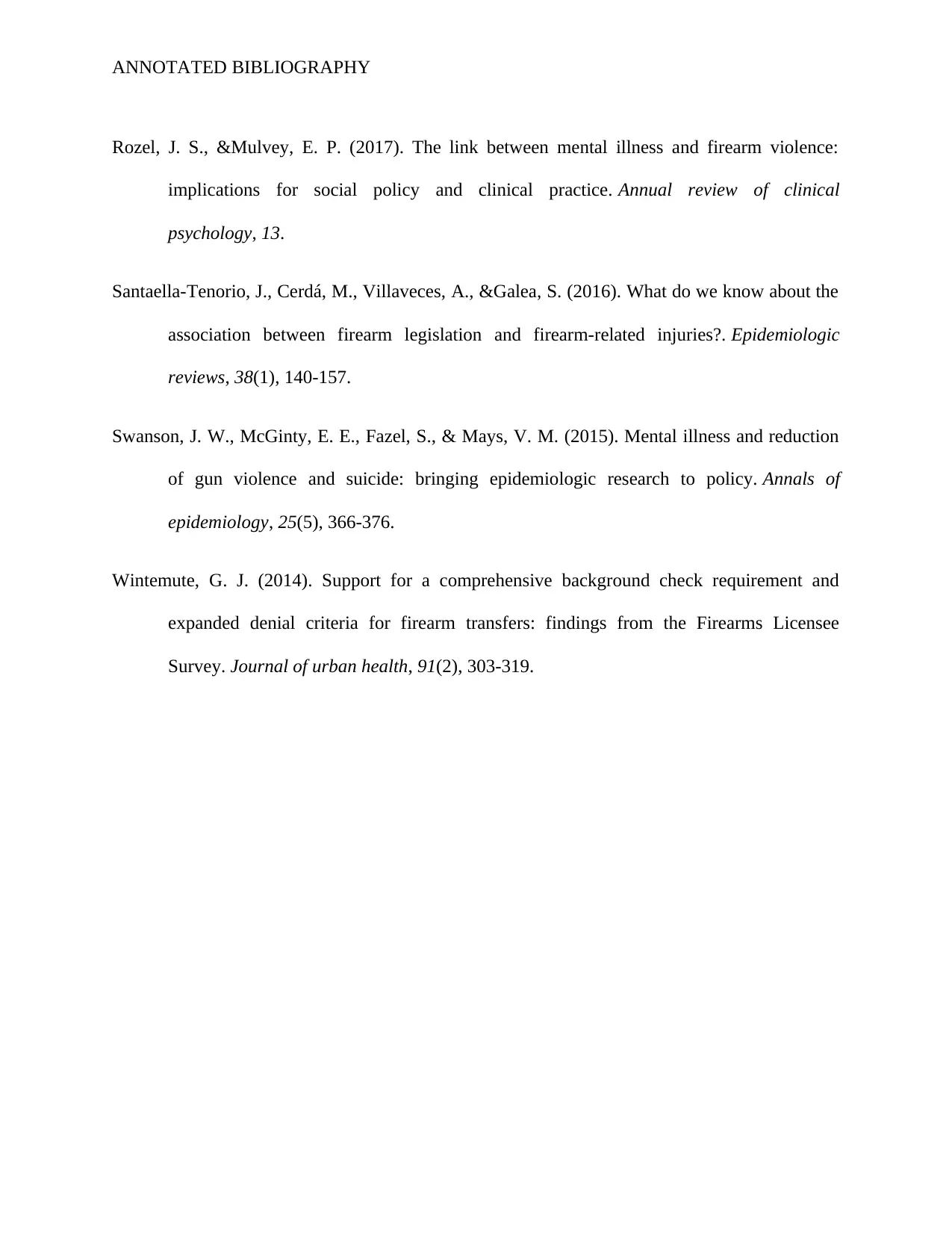
ANNOTATED BIBLIOGRAPHY
Rozel, J. S., &Mulvey, E. P. (2017). The link between mental illness and firearm violence:
implications for social policy and clinical practice. Annual review of clinical
psychology, 13.
Santaella-Tenorio, J., Cerdá, M., Villaveces, A., &Galea, S. (2016). What do we know about the
association between firearm legislation and firearm-related injuries?. Epidemiologic
reviews, 38(1), 140-157.
Swanson, J. W., McGinty, E. E., Fazel, S., & Mays, V. M. (2015). Mental illness and reduction
of gun violence and suicide: bringing epidemiologic research to policy. Annals of
epidemiology, 25(5), 366-376.
Wintemute, G. J. (2014). Support for a comprehensive background check requirement and
expanded denial criteria for firearm transfers: findings from the Firearms Licensee
Survey. Journal of urban health, 91(2), 303-319.
Rozel, J. S., &Mulvey, E. P. (2017). The link between mental illness and firearm violence:
implications for social policy and clinical practice. Annual review of clinical
psychology, 13.
Santaella-Tenorio, J., Cerdá, M., Villaveces, A., &Galea, S. (2016). What do we know about the
association between firearm legislation and firearm-related injuries?. Epidemiologic
reviews, 38(1), 140-157.
Swanson, J. W., McGinty, E. E., Fazel, S., & Mays, V. M. (2015). Mental illness and reduction
of gun violence and suicide: bringing epidemiologic research to policy. Annals of
epidemiology, 25(5), 366-376.
Wintemute, G. J. (2014). Support for a comprehensive background check requirement and
expanded denial criteria for firearm transfers: findings from the Firearms Licensee
Survey. Journal of urban health, 91(2), 303-319.
Paraphrase This Document
Need a fresh take? Get an instant paraphrase of this document with our AI Paraphraser

ANNOTATED BIBLIOGRAPHY
1 out of 11
Related Documents
Your All-in-One AI-Powered Toolkit for Academic Success.
+13062052269
info@desklib.com
Available 24*7 on WhatsApp / Email
![[object Object]](/_next/static/media/star-bottom.7253800d.svg)
Unlock your academic potential
Copyright © 2020–2025 A2Z Services. All Rights Reserved. Developed and managed by ZUCOL.





